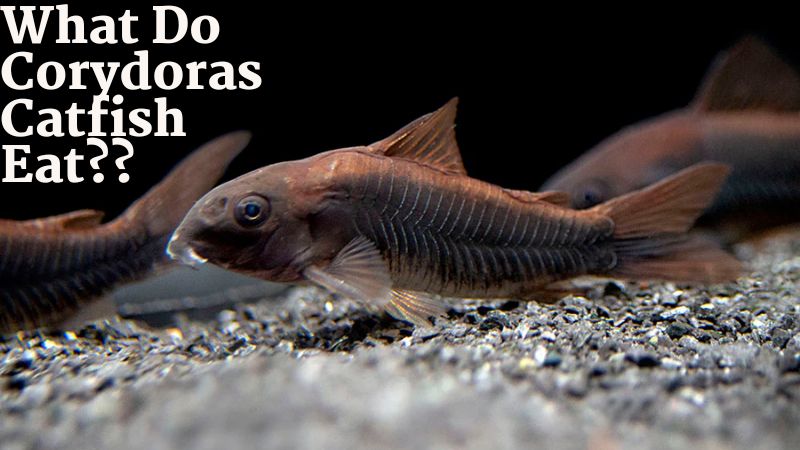Corydoras catfish, also known as corydoras or corys for short, are popular aquarium fish beloved for their peaceful nature and bottom-dwelling antics. These active scavengers play a vital role in maintaining a clean tank by sifting through the substrate for leftover food and detritus. But exactly what do Corydoras Catfish eat? Let’s explore with Tropical Fish Haven!
What are Corydoras?
This group of South American catfish comprises over 160 species, with several hundred more awaiting classification. In the aquarium hobby, they typically range from 1 to 3 inches in length and are named for their bony armor-like plates. To defend against predators, these small catfish also possess sharp fin spines that can release a mild venom when stressed (thus, caution is advised when handling them bare-handed).
Most cory catfish species thrive in temperatures between 72 and 82°F. For instance, peppered cory catfish (Corydoras paleatus) and julii cory catfish (Corydoras julii) prefer cooler temperatures, while sterbai cory catfish (Corydoras sterbai) can tolerate higher temperatures.
In the wild, corydoras typically gather in sizable groups ranging from 20 to several hundred individuals of the same species. They are most active during daylight hours, with their peak periods of activity at dawn and dusk. Commonly sought-after varieties in the aquarium hobby include bronze cory (Corydoras aeneus), albino cory (Corydoras aeneus var. albino), panda cory (Corydoras panda), emerald green cory (Corydoras splendens), and pygmy cory (Corydoras pygmaeus).
How Much Space Do Cory Catfish Require?
For dwarf species, a 10-gallon tank may suffice, but we recommend 20 gallons or larger for most other types. Since they thrive in groups, it’s ideal to keep six or more corydoras of the same species together. These peaceful bottom-dwellers can coexist with nearly any community fish that won’t prey on or harass them. (Avoid housing corydoras with goldfish, for example, as goldfish grow large and can ingest anything small enough.)
For those considering tank setups, a 20-gallon aquarium could accommodate a school of cory catfish at the bottom, another school of small tetras in the middle layer, and perhaps a centerpiece fish like a honey gourami. Adding some vibrant aquarium plants completes a thriving ecosystem right in your living space!
What Do Corydoras Catfish Eat?
Corydoras catfish are opportunistic feeders, meaning they’ll gobble up anything tasty and small enough to fit in their mouths. While not picky eaters, they particularly love worms! Live blackworms, frozen bloodworms, and Hikari Vibra Bites (bloodworm-shaped treats) are all surefire hits.
Their diet shouldn’t rely solely on algae wafers or community flakes, as these don’t provide the complete nutrition they need. Opt for sinking carnivore pellets, Repashy gel foods, or other sinking foods specifically designed for bottom feeders.
Living with faster, more aggressive eaters can be a challenge for Corydoras. To ensure they get their fair share, target feed them sinking foods after turning off tank lights or during a dedicated feeding time. This reduces competition and helps your Corydoras thrive.
Description Cory Catfish
Cory Catfish has armor, a short face, and a flat underside. They have pectoral fins that protrude and lie on the surface. Their dorsal fins point upward like a sail, but some breeds have more rounded fins. The caudal fin is often forked, but length and height also vary between species.
Like other Catfish species, they have 3 pairs of barbs on their faces that are used to detect food in the sand.
They also have wide eyes with a clear ring around them, making them look recognizable and adorable.
Many species have colors that blend into the brown of the river bottom, but some are pale (like the albino) or shimmering (like the emerald Cory Catfish).
With a variety of colors, you can find the right one for your tank.
Longevity
In the wild, Cory Catfish live for 5-7 years. In captivity, Cory Catfish can live longer.
Under the right conditions, Cory Catfish can live up to 12-15 years. There have even been cases where Cory lived up to 20 years.
Size
Corydoras are quite small for Catfish standards. In general, size ranges from 4-7 cm (1.5 – 2.5 inches) depending on the species.
That said, breeding females can reach up to 7.62 cm (3 inches).
Caring For Cory Catfish
These fish need a suitable habitat to thrive. It needs to be cleaned weekly such as removing excess waste from gravel and cleaning the fish tank glass. They often hide while you clean but will appear immediately after the tank is cleaned. When cleaning, try not to stress them too much because they will secrete
The poison can kill other species.
Change 20% of the water every week. Be sure to dechlorinate the new water and add water slowly as disturbing the substrate can lead to ammonia spikes.
Aquarium
Overall, Cory Catfish are quite easy to care for. They do not require a large tank and are quite forgiving when it comes to water conditions. Cory Catfish also get along very well with other fish – this combination makes them great for beginner fish keepers.
Tank size: Corydoras are small, beautiful fish. Technically, a Corydoras will only need a 37.8 liter (10 gallon) tank. Unfortunately, Corydoras cannot live happily alone, they need to live with 5 or more other Corydoras. If the tank has 5 Corydoras then a 75.7 liter (20 gallon) tank is the minimum.
Substrate
Unlike most freshwater fish, Corydoras are not suited to gravel – the jagged edges can damage their fins and stomachs.
Sand
The best choice when it comes to raising Corydoras. Soft sand will not damage Corydoras antennae. You should choose “sunset” yellow sand to help the aquarium appear less dirty.
While sand is certainly the best choice, it causes problems with live plants. Sand has a low CEC (Cation Exchange Capacity) – so plant roots are needed to provide your plants with the appropriate nutrients.
Water parameters
Although Cory Catfish are not difficult to keep, it is still necessary to provide a pristine environment to help the fish grow and stay healthy.
General parameters for Corydoras species: pH from 6 – 8, temperature from 21 – 26.7oC (70 – 80oF), alkalinity from 3 – 10odKH. If the parameter is off by a few degrees, adjust it to make it as stable as possible.
Cory Catfish are especially sensitive to ammonia, nitrites and nitrates. Always change the water every 2 weeks to help lower nitrate levels to a safe level.
Add live plants
Corydoras are not picky about plants – in fact, any species should be used. Some types such as Anubias Nana, Java fern, Crypts, Hornwort, and Java moss are aquatic plants that do not need much light.
bright or pristine water conditions.
In addition to plants, Corydoras like to hide in shelves of driftwood and slate. Feel free to get creative with your layout and layout.
Light
Live plants require good light to thrive. LED fixtures should be used because they are more so – they last longer, radiate much less heat and produce stronger plants.
Although light is important for plants, Cory Catfish tend to prefer low-light environments. Corydoras are very adaptable and will adjust to any light.
Just try to make sure there are a few caves or similar structures for your Corydoras to escape the light from time to time.
Conclusion
Providing a varied diet that caters to their omnivorous nature is key to keeping your corydoras happy and healthy. A combination of sinking tablets or wafers, occasional treats like bloodworms or brine shrimp, and algae supplements will ensure they get the proper nutrients to flourish in your aquarium. By understanding their natural feeding habits and offering a balanced diet, you can keep your corydoras catfish scavenging and thriving for years to come.





